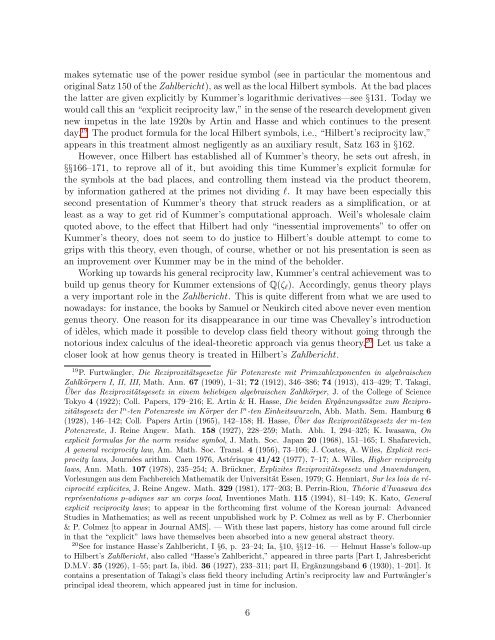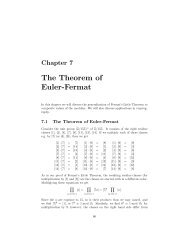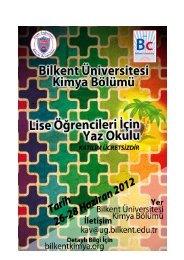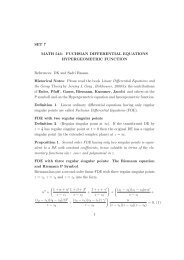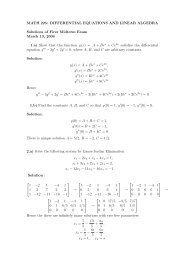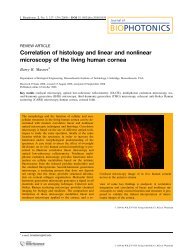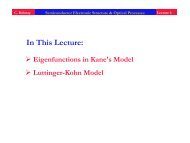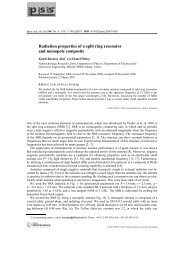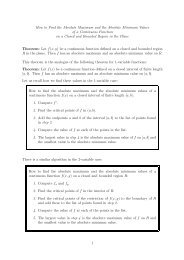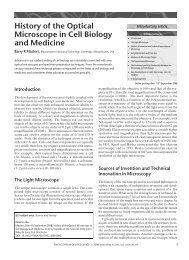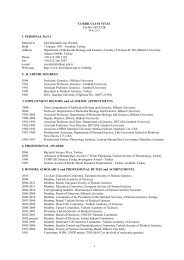Introduction to the English Edition of Hilbert's Zahlbericht
Introduction to the English Edition of Hilbert's Zahlbericht
Introduction to the English Edition of Hilbert's Zahlbericht
Create successful ePaper yourself
Turn your PDF publications into a flip-book with our unique Google optimized e-Paper software.
makes sytematic use <strong>of</strong> <strong>the</strong> power residue symbol (see in particular <strong>the</strong> momen<strong>to</strong>us and<br />
original Satz 150 <strong>of</strong> <strong>the</strong> <strong>Zahlbericht</strong>), as well as <strong>the</strong> local Hilbert symbols. At <strong>the</strong> bad places<br />
<strong>the</strong> latter are given explicitly by Kummer’s logarithmic derivatives—see §131. Today we<br />
would call this an “explicit reciprocity law,” in <strong>the</strong> sense <strong>of</strong> <strong>the</strong> research development given<br />
new impetus in <strong>the</strong> late 1920s by Artin and Hasse and which continues <strong>to</strong> <strong>the</strong> present<br />
day. 19 The product formula for <strong>the</strong> local Hilbert symbols, i.e., “Hilbert’s reciprocity law,”<br />
appears in this treatment almost negligently as an auxiliary result, Satz 163 in §162.<br />
However, once Hilbert has established all <strong>of</strong> Kummer’s <strong>the</strong>ory, he sets out afresh, in<br />
§§166–171, <strong>to</strong> reprove all <strong>of</strong> it, but avoiding this time Kummer’s explicit formulæ for<br />
<strong>the</strong> symbols at <strong>the</strong> bad places, and controlling <strong>the</strong>m instead via <strong>the</strong> product <strong>the</strong>orem,<br />
by information ga<strong>the</strong>red at <strong>the</strong> primes not dividing ℓ. It may have been especially this<br />
second presentation <strong>of</strong> Kummer’s <strong>the</strong>ory that struck readers as a simplification, or at<br />
least as a way <strong>to</strong> get rid <strong>of</strong> Kummer’s computational approach. Weil’s wholesale claim<br />
quoted above, <strong>to</strong> <strong>the</strong> effect that Hilbert had only “inessential improvements” <strong>to</strong> <strong>of</strong>fer on<br />
Kummer’s <strong>the</strong>ory, does not seem <strong>to</strong> do justice <strong>to</strong> Hilbert’s double attempt <strong>to</strong> come <strong>to</strong><br />
grips with this <strong>the</strong>ory, even though, <strong>of</strong> course, whe<strong>the</strong>r or not his presentation is seen as<br />
an improvement over Kummer may be in <strong>the</strong> mind <strong>of</strong> <strong>the</strong> beholder.<br />
Working up <strong>to</strong>wards his general reciprocity law, Kummer’s central achievement was <strong>to</strong><br />
build up genus <strong>the</strong>ory for Kummer extensions <strong>of</strong> Q(ζℓ). Accordingly, genus <strong>the</strong>ory plays<br />
a very important role in <strong>the</strong> <strong>Zahlbericht</strong>. This is quite different from what we are used <strong>to</strong><br />
nowadays: for instance, <strong>the</strong> books by Samuel or Neukirch cited above never even mention<br />
genus <strong>the</strong>ory. One reason for its disappearance in our time was Chevalley’s introduction<br />
<strong>of</strong> idèles, which made it possible <strong>to</strong> develop class field <strong>the</strong>ory without going through <strong>the</strong><br />
no<strong>to</strong>rious index calculus <strong>of</strong> <strong>the</strong> ideal-<strong>the</strong>oretic approach via genus <strong>the</strong>ory. 20 Let us take a<br />
closer look at how genus <strong>the</strong>ory is treated in Hilbert’s <strong>Zahlbericht</strong>.<br />
19 P. Furtwängler, Die Reziprozitätsgesetze für Potenzreste mit Primzahlexponenten in algebraischen<br />
Zahlkörpern I, II, III, Math. Ann. 67 (1909), 1–31; 72 (1912), 346–386; 74 (1913), 413–429; T. Takagi,<br />
Über das Reziprozitätsgesetz in einem beliebigen algebraischen Zahlkörper, J. <strong>of</strong> <strong>the</strong> College <strong>of</strong> Science<br />
Tokyo 4 (1922); Coll. Papers, 179–216; E. Artin & H. Hasse, Die beiden Ergänzungssätze zum Rezipro-<br />
zitätsgesetz der l n -ten Potenzreste im Körper der l n -ten Einheitswurzeln, Abh. Math. Sem. Hamburg 6<br />
(1928), 146–142; Coll. Papers Artin (1965), 142–158; H. Hasse, Über das Reziprozitätsgesetz der m-ten<br />
Potenzreste, J. Reine Angew. Math. 158 (1927), 228–259; Math. Abh. I, 294–325; K. Iwasawa, On<br />
explicit formulas for <strong>the</strong> norm residue symbol, J. Math. Soc. Japan 20 (1968), 151–165; I. Shafarevich,<br />
A general reciprocity law, Am. Math. Soc. Transl. 4 (1956), 73–106; J. Coates, A. Wiles, Explicit reciprocity<br />
laws, Journées arithm. Caen 1976, Astérisque 41/42 (1977), 7–17; A. Wiles, Higher reciprocity<br />
laws, Ann. Math. 107 (1978), 235–254; A. Brückner, Explizites Reziprozitätsgesetz und Anwendungen,<br />
Vorlesungen aus dem Fachbereich Ma<strong>the</strong>matik der Universität Essen, 1979; G. Henniart, Sur les lois de réciprocité<br />
explicites, J. Reine Angew. Math. 329 (1981), 177–203; B. Perrin-Riou, Théorie d’Iwasawa des<br />
représentations p-adiques sur un corps local, Inventiones Math. 115 (1994), 81–149; K. Ka<strong>to</strong>, General<br />
explicit reciprocity laws; <strong>to</strong> appear in <strong>the</strong> forthcoming first volume <strong>of</strong> <strong>the</strong> Korean journal: Advanced<br />
Studies in Ma<strong>the</strong>matics; as well as recent unpublished work by P. Colmez as well as by F. Cherbonnier<br />
& P. Colmez [<strong>to</strong> appear in Journal AMS]. — With <strong>the</strong>se last papers, his<strong>to</strong>ry has come around full circle<br />
in that <strong>the</strong> “explicit” laws have <strong>the</strong>mselves been absorbed in<strong>to</strong> a new general abstract <strong>the</strong>ory.<br />
20See for instance Hasse’s <strong>Zahlbericht</strong>, I §6, p. 23–24; Ia, §10, §§12–16. — Helmut Hasse’s follow-up<br />
<strong>to</strong> Hilbert’s <strong>Zahlbericht</strong>, also called “Hasse’s <strong>Zahlbericht</strong>,” appeared in three parts [Part I, Jahresbericht<br />
D.M.V. 35 (1926), 1–55; part Ia, ibid. 36 (1927), 233–311; part II, Ergänzungsband 6 (1930), 1–201]. It<br />
contains a presentation <strong>of</strong> Takagi’s class field <strong>the</strong>ory including Artin’s reciprocity law and Furtwängler’s<br />
principal ideal <strong>the</strong>orem, which appeared just in time for inclusion.<br />
6


